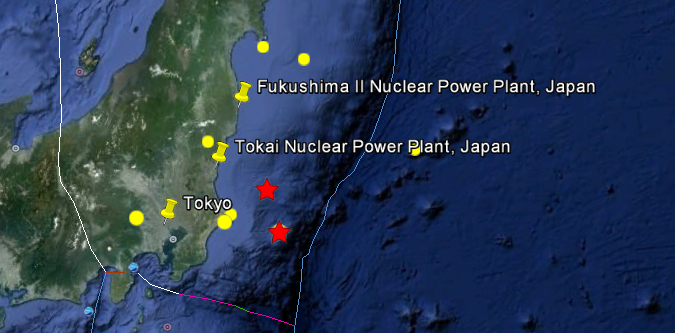Tokai Nuclear Power Plant in Japan leaked about 1.5 tonnes of radioactive water

Japan’s nuclear safety watchdog Monday said a leakage of about 1.5 tonnes of low-level radioactive water occurred at a plant of Japan Atomic Power Co. in the village of Tokai in Ibaraki Prefecture.
The Nuclear and Industrial Safety Agency launched an investigation to check whether the water had leaked into the sea.
The water was used to decontaminate radiation protection suits and other items and was contaminated to an extent of 33 becquerels per gram, adding that the leakage occurred when water was transferred from a storage tank to another tank of a nuclear reactor during decommissioning Wednesday (RSOE-EDIS)
The Tōkai Nuclear Power Plant (東海原子力発電所 Tōkai genshi-ryoku hatsuden-sho, Tōkai NPP) was Japan’s first nuclear power plant. It was built in the early 1960s to the British Magnox design, and generated power from 1966 until it was decommissioned in 1998. A second nuclear plant, built at the site in the 1970s, was the first in Japan to produce over 1000 MW of electricity.
Following the 2011 Tōhoku earthquake and tsunami the number 2 reactor was shut down automatically. It has been suggested that the reactor should not be restarted and should be decommissioned.
Recent incidents
Following the 2011 Tōhoku earthquake and tsunami the number 2 reactor was one of eleven nuclear reactors nationwide to be shut down automatically. It was reported on 14 March that a cooling system pump for the number 2 reactor had stopped working. Japan Atomic Power Company stated that there was a second operational pump and cooling was working, but that two of three diesel generators used to power the cooling system were out of order.
In 2007, Ibaraki Prefecture took action to shield the facility from tsunami with height of 5.7 metre, and additions to the seawall were made to a 6.1 metre height 2 days before 2011 Tōhoku earthquake and tsunami, 9 March 2011. A 5.4 metre tsunami arrived on 11 March at the plant. These fact are disclose to news media at the time of plant inspection by government on 13 February 2012.
During the earthquake of 11 March 2011, the Tokai-power plant suffered external power-loss, just like it happened in Fukushima. Thanks to extra and voluntarily measurements taken by the Japan Atomic Power, the reactors could still be cooled safely, and another major accident was prevented. In 2002 was concluded, based on an evaluation technology adopted by the Japan Society of Civil Engineers, that at this place tsunami waves could be expected as high as 4.86 meters. The government of the prefecture Ibaraki in October 2007 had their own calculations published, and estimated that these waves could be as high as 6 to 7 meters. Japan Atomic Power changed its wave level assumption to 5.7 meters. The reconstruction works were started in July 2009 to raise the height of the 4.9-meter protection around the plant to 6.1 meters, in order to protect the seawater pumps designed to cool an emergency diesel generator. Although most of the works were completed by September 2010, cable holes in the levee were still not fully covered. This work was scheduled to take place before around May 2011. When the tsunami did hit the Tokai plant in March, the waves were 5.3 to 5.4 meters in height, even higher than earlier estimations but still 30 to 40 centimeters lower than the last assumption. The Tokai plant suffered a loss of external power-supply like it happened in Fukushima. Even the levee was overrun in Tokai, but only one of three seawater pumps did fail, and the reactors could be kept stable and safe in cold shutdown with the emergency diesel generator cooled by the two remaining seawater pumps.
After the disaster in Fukushima a stress-test was ordered by the Japanese government, after investigations the electrical installations of the Tokai Daini reactor did not meet the earthquake-resistance standards set by the government.
Featured image: Google Earth + USGS latest earthquakes

Lies I’m sure